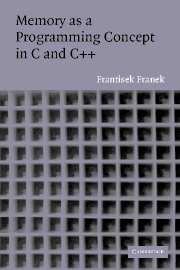Book contents
- Frontmatter
- Contents
- Acknowledgments
- Dedication
- 1 Introduction
- 2 From Source File to Executable File
- 3 Variables and Objects; Pointers and Addresses
- 4 Dynamic Allocation and Deallocation of Memory
- 5 Functions and Function Calls
- 6 One-Dimensional Arrays and Strings
- 7 Multi-Dimensional Arrays
- 8 Classes and Objects
- 9 Linked Data Structures
- 10 Memory Leaks and Their Debugging
- 11 Programs in Execution: Processes and Threads
- A Hanoi Towers Puzzle
- B Tracing Objects in C++
- C Tracing Objects and Memory in C++
- D Thread-Safe and Process - Safe Reporting and Logging Functions
- Glossary
- Index
9 - Linked Data Structures
Published online by Cambridge University Press: 13 January 2010
- Frontmatter
- Contents
- Acknowledgments
- Dedication
- 1 Introduction
- 2 From Source File to Executable File
- 3 Variables and Objects; Pointers and Addresses
- 4 Dynamic Allocation and Deallocation of Memory
- 5 Functions and Function Calls
- 6 One-Dimensional Arrays and Strings
- 7 Multi-Dimensional Arrays
- 8 Classes and Objects
- 9 Linked Data Structures
- 10 Memory Leaks and Their Debugging
- 11 Programs in Execution: Processes and Threads
- A Hanoi Towers Puzzle
- B Tracing Objects in C++
- C Tracing Objects and Memory in C++
- D Thread-Safe and Process - Safe Reporting and Logging Functions
- Glossary
- Index
Summary
Fundamentals, advantages, and disadvantages of linked data structures. Moving a linked data structure in memory, or to/from a disk, or transmitting it across a communication channel - techniques of compaction and serialization. Memory allocation from a specific arena.
Linked data structures are intimately related to memory, where they are created, located, and processed. Naturally for this book, this relationship with memory is our principal focus in this chapter. It is not our intention to provide a comprehensive presentation of linked data structures in C or C++ and their applications. There are many excellent books on the topic of algorithms and data structures, particularly in C and C++.
Linked data structures and their applications are one of the great successes of the early decades of computer science. The reader can easily imagine how useful software would be if it worked solely with numbers and arrays. But how then would we model and program such things as lists, graphs, stacks, queues, charts, diagrams, and many other abstract notions that are needed to deal with today's complex programming tasks?
Philosophically, a linked approach to data structures is used for any of the following reasons: the data structure must be created dynamically; each part of it is created at a different time; the mutual relations of the parts change in time. Sometimes links are used as a “physical” implementation of “logical relations” (the best example would be databases and the use of foreign keys as “links”).
- Type
- Chapter
- Information
- Memory as a Programming Concept in C and C++ , pp. 132 - 158Publisher: Cambridge University PressPrint publication year: 2003
- 1
- Cited by



